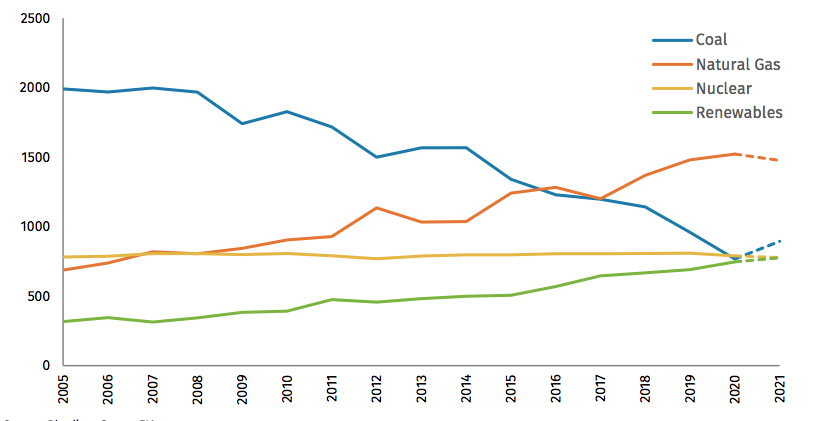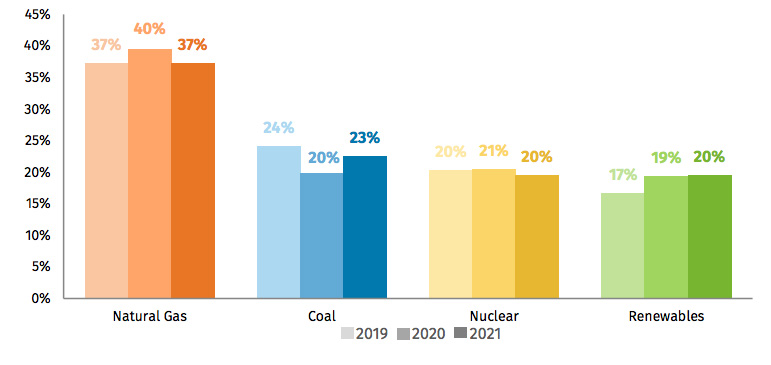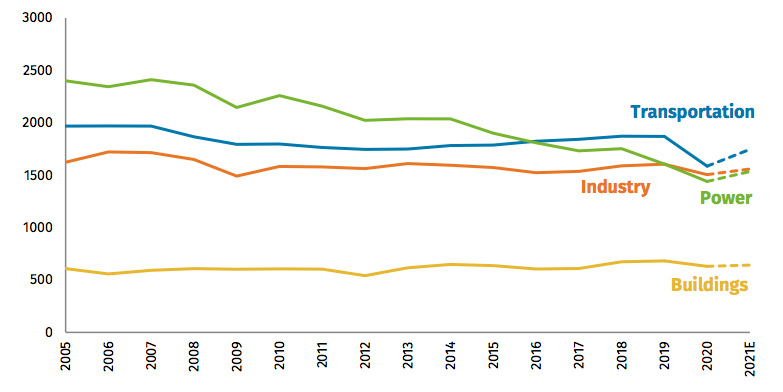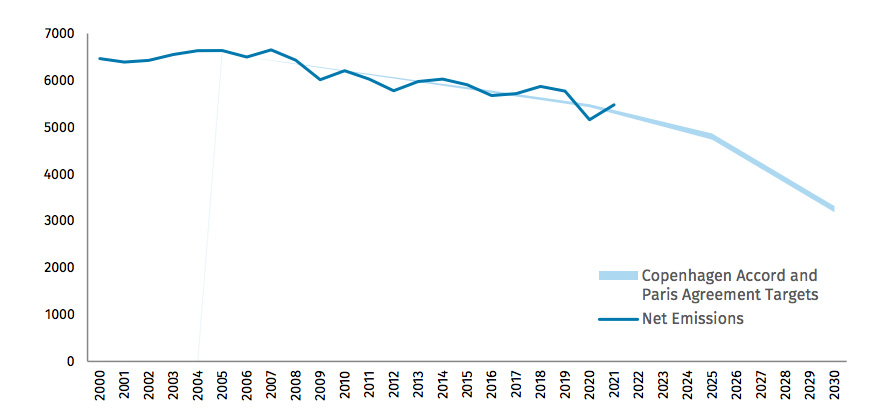
Coal and trucks pushed US ‘further off track’ for climate targets in 2021
Josh Gabbatiss
01.10.22Josh Gabbatiss
10.01.2022 | 12:39pmUS emissions surged by 6.2% last year, boosted by a renewed reliance on coal power amid soaring natural gas prices, according to the Rhodium Group.
After falling sharply in 2020 due to the economic impact of Covid-19, transport emissions also saw a significant uptick in 2021, buoyed by the return of freight trucks to the nation’s highways.
Preliminary data released by the research organisation also shows that renewables generated a fifth of US electricity last year, putting wind, solar, biomass and hydropower on a par with nuclear power for the first time in decades.
This follows the largest drop in US emissions since World War II during the first year of Covid-19. Even with the rebound, 2021 emissions remained 5% below pre-pandemic levels.
Nevertheless, the Rhodium Group says that last year’s increase puts the nation “even further off track” from achieving its rapidly approaching emissions targets, as the Biden administration’s efforts to push climate legislation through Congress continue to falter.
Renewables up
New wind and solar capacity in 2021 drove an overall increase in US renewable power generation in 2021, reflecting the relative resilience of the sector to Covid-19 impacts.
The 4% increase in generation was around half the growth rate seen in 2020, but despite this slower pace and a slight dip in hydropower generation, the Rhodium Group notes that renewables reached “20% of US electricity generation for the first time”.
As the chart below shows, this means that last year renewables (green) matched nuclear (yellow) generation, which experienced a slight dip as plants such as Indian Point in New York shut down.

The last time these two power sources were evenly matched would have been around the early 1980s when hydro projects generated more electricity than the nation’s fledgeling nuclear industry.
The Rhodium Group results are supported by US Energy Information Administration (EIA) data. In fact, an early December forecast from the EIA suggested renewables would exceed nuclear generation, producing 824 terawatt hours (TWh) in 2021, compared to 779TWh for nuclear.
As US nuclear plants close without new ones to replace them, some have argued that they tend to be replaced by fossil fuel plants rather than other clean power sources.
The first reactors for decades were approved at the Vogtle nuclear power plant in Georgia in 2012, but they remain the only ones under construction across the country.
In 2021 at least, the share of clean power remained the same, with a 1% dip in nuclear made up for by a 1% increase in renewable generation, according to the Rhodium Group.
Coal’s resurgence
Despite the steady share of low-carbon electricity sources in 2021, the power sector, which accounts for 28% of US greenhouse gases, saw a 6.6% increase in emissions in 2021 compared to the previous year.
Some of this rise came from a 3% increase in electricity demand as lockdown restrictions eased and the US economy scaled up again. However, the Rhodium Group concludes that the main driver was a surge in coal combustion, after years of decline.
In October, the US EIA announced that it expected annual coal-fired electricity generation to increase in 2021 for the first time in seven years.
This is confirmed by the Rhodium Group’s analysis, which shows coal generation rising sharply by 17% last year.
Generally, coal and natural gas have been the two largest sources of power in the US, although coal generation dipped slightly below nuclear in 2020.
In many parts of the US, the two compete to provide electricity and soaring gas costs last year, combined with relatively stable coal prices, mean the latter has often been favoured. While both are fossil fuels, coal produces far more carbon dioxide (CO2) than gas when burned.
The chart below shows the relative shares of generation taken by major power sources across the past three years, with coal (blue) showing the largest increase last year and reclaiming its place as the second largest source.

However, the EIA has stated that in 2022, coal generation will likely drop by around 5% as coal power plants are retired and natural gas prices fall slightly.
The US has the second-largest coal fleet in the world, but many plants have already been decommissioned and a third of the remaining fleet is expected to close by 2030.
Returning transport
While the power sector is significant, its emissions are exceeded by transport, which at 31% is not only the largest source of US emissions, but also saw the steepest increase in emissions last year – a 10% rise.
This largely reflects the fact that this sector saw the sharpest decline in emissions the previous year, as Covid-19 lockdowns and other restrictions saw many confined to their homes and local areas.
The chart below shows the particularly dramatic trajectory followed by transport over the past two years. As with other sectors, transport emissions still remain below pre-pandemic levels.

The only mode of transport that exceeded 2019 levels was road freight. Consequently, diesel – the fuel used to power large freight trucks – saw demand reach levels 0.4% higher than they were before the pandemic.
Climate targets
According to the Rhodium Group’s analysis, 2021 emissions were 17.4% below 2005 levels, up from 22.2% below 2005 levels in 2020.
Under the US’s updated nationally determined contribution (NDC) towards the Paris Agreement, announced last year by president Joe Biden, the nation is aiming to cut its greenhouse gas emissions to 50-52% below 2005 levels by 2030.
The Biden administration has also submitted an updated long-term strategy to the UN Framework Convention on Climate Change (UNFCCC), committing the country to reach net-zero emissions by 2050 at the latest.
Climate Action Tracker (CAT), which assesses national climate commitments, has concluded that while the new US 2030 target is an “ambitious” step forward, it is not in line with the Paris Agreement target of limiting global warming to 1.5C. CAT has proposed an emissions reduction target of 57-63% below 2005 levels to be consistent with that target.
Research suggests that Biden’s flagship “build back better” act, which involves billions in spending on renewables and electric cars, would result in significant cuts to US emissions – but would still not meet the current 2030 target. Due to opposition from the Republican party and West Virginia Democrat senator Joe Manchin, even these measures are currently in limbo.
The Rhodium Group says its new analysis shows these targets have been pushed “even further off track”, as the chart below shows – with a trajectory to achieve US climate targets in light blue and actual emissions in dark blue.

However, the group’s preliminary analysis points to its own recent work which lays out a pathway to the 2030 goal. “Joint accelerated action by Congress, the federal executive branch, and leading states can put the 2030 target within reach, but all must act quickly in order to put the US on track,” it concludes.
-
Coal and trucks pushed US ‘further off track’ for climate targets in 2021
-
US renewable power equals nuclear for first time in decades, data reveals

